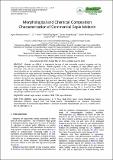Morphological and Chemical Composition Characterization of Commercial Sepia Melanin

View/
Date
2015Author
Mbonyiryivuze, Agnes
Nuru, Z. Y.
Ngom, Balla Diop
Mwakikunga, Bonex
Dhlamini, Simon Mokhotjwa
Park, Eugene
Maaza, Malik
Metadata
Show full item recordAbstract
Melanins are difficult to characterize because of their intractable chemical properties and the heterogeneity in their structural features. Melanin pigments, in fact, are composed of many different types of monomeric units that are connected through strong carbon-carbon bonds. Its high insolubility and undefined chemical entities are two obstacles in its complete characterization. The morphological characterization and particle size distribution for sepia melanin by Scanning Electron Microscopy (SEM) on surface structure and Transmission Electron Microscopy (TEM) to confirm the morphology obtained from SEM was done. Both results show that Sepia melanin is formed by many aggregates agglomerated together. These aggregates are formed also by small spherical granules with different size distributions that have been determined using image-J software. The small granule diameter obtained from different TEM and SEM micrographs were 100-200nm. EDS reveals that C and O were the most abundant in sepia melanin with concentration average concentrations of about 57% and 24% respectively. The major compositions of sepia melanin are C, O, Na, Cl, while the minor are Mg, Ca, K, S and N. From TEM micrograph at high resolution, it was possible to measure the distance between polymers layers of sepia melanin using image-J software and it was 0.323 nm = 3.23 Å.
